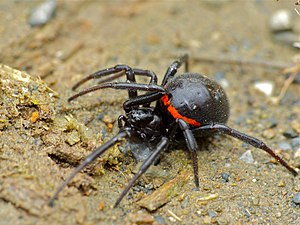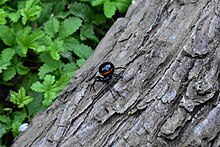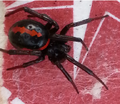False black widow
| False black widow | ||||||||||||
|---|---|---|---|---|---|---|---|---|---|---|---|---|

False black widow ( Steatoda paykulliana ), female |
||||||||||||
| Systematics | ||||||||||||
|
||||||||||||
| Scientific name | ||||||||||||
| Steatoda paykulliana | ||||||||||||
| ( Walckenaer , 1806) |
The false black widow ( Steatoda paykulliana ) is a spider from the family of the crested web spiders (Theridiidae). Like most other fat spiders from the genus Steatoda, it is very similar to the real widows ( Latrodectus ) and is therefore simply referred to as the false widow . This trivial name is not unambiguous, however, as it is used for several types of fat spiders that are similar to the real widows.
features
With a body length of eight to thirteen millimeters for the females and 4.5 to 8.4 millimeters for the males, the false black widow is one of the largest crested web spiders in Europe. The prosoma (front body) is dark purple to brown or black in color in the female. It has brown legs and a black opisthosoma (abdomen). Its front edge is marked by a band and its center is taken up by a serrated longitudinal band. These bands can appear both white and light yellowish or bright red. The ventral side of the opisthosoma in the female is dark brown and has several red-brown markings. The epigyne (female sex organ) is provided with strongly chitinized ridges.
The prosoma of the male lacks the purple sheen of color that is present in the female. Otherwise there are no differences here. The legs of the male have a yellow-brown basic color. The coxae (hip limbs), the thigh rings and the patellae (limbs between the femora (thigh) and the tibia in the jawbone bearers) and also the apical sides of other leg limbs are somewhat darker. The comparatively short pedipalps (transformed extremities in the head area of arachnids) of the male are striking . The coloring of the opisthosoma of the male is similar to that of the female.
Similar species

Among the already mentioned similarity to species from the genus of the real widows ( Latrodectus ), that with the European black widow ( Latrodectus tredecimguttatus ), with which the false black widow is often confused, should be emphasized. The European black widow is slightly larger and has a different color pattern than the false black widow. Another significant difference is the chelicerae (jaw claws) that are present in fat spiders but lack in true widows .
Occurrence

The false black widow lives particularly in parts of southern Europe and across the whole of the Mediterranean . Their distribution area extends to Central Asia. To the north it ends in the Southern Alps . The preferred habitat of the false black widow are mainly dry areas of all kinds, where the spider can be found under stones.
Threat and protection
The false black widow can often be found in their habitat and is therefore not threatened. The IUCN does not evaluate the population of the species.
Way of life
In its habitat, the false black widow, like almost all crested web spiders, creates a safety net, consisting of a net blanket from which catch threads run diagonally down to the ground. The safety net is often placed close to the ground or directly on the ground. Accordingly, ground-dwelling arthropods , such as various ants , woodlice and beetles, get caught in the net as prey . The predominantly nocturnal spider usually hides during the day in a shelter made on the web, while at night it often sits in the web.
Phenology and reproduction

While adult females of the false black widow appear to be found all year round, this is only the case with the males in spring (May) and from late summer to autumn. The mating season of the species begins in summer. At this time, the males can often be seen on the edge of the females' nets. The male performs a courtship in which he alternately moves the pedipalps and the front legs up and down. If the female is willing to mate, it will approach the male. The courtship usually lasts 23 to 28 minutes, the actual mating only three to five minutes. Since cannibalism on the part of the female can occur with the false black widow, as with other spiders , the male tries to flee after mating if he is still able to.
Six to seven days after mating, the female begins building the cocoon . It makes a single and more often two to three white and yellowish-filled egg cocoons, each containing around 65 eggs. This process takes 25 to 26 days. The young spiders themselves hatch after 68 to 69 days and then grow, which can take between 77 and 80 days. The total lifespan is then around 155 days for males and around 163 days for females.
Toxicity and bite accidents
Like other fat spiders and true widows, it is also possible for the false black widow to penetrate human skin with her chelicerae. Like other crested web spiders, however, it is not aggressive and only bites in extreme need, although the species is considered more biting than the real widows.
As with all fat spiders, the symptoms of the bite are described as steatodism . The poison of the false black widow, like that of the real widow, is apparently neurotoxic ( nerve poison ), but has a significantly weaker effect than that of the real widow, which makes the false widow far safer.
Systematics
Like other spider species already described in the 18th or early 19th century, the false black widow was also increasingly renamed and rearranged, which in the case of this species mainly concerned the membership of the genera. Charles Athanase Walckenaer called the false black widow in the first description in 1805 and 1806 Theridion paykullianum . The current name Steatoda paykulliana was first coined in 1964 by Zvonimir Maretić and Herbert Walter Levi and his wife Lorna Rose Levi and has been used since then.
gallery
Individual evidence
- ↑ a b c d e f g h i j k Steatoda paykulliana (Walckenaer, 1805) at araneae Spiders of Europe, by Wolfgang Nentwig, Theo Blick, Robert Bosmans, Daniel Gloor, Ambros Hänggi & Christian Kropf , accessed on February 13, 2020 .
- ↑ a b c d e f g h i j Heiko Bellmann: The cosmos spider leader. Over 400 species in Europe. 2nd Edition. Kosmos Naturführer, Kosmos (Franckh-Kosmos), 2016, ISBN 978-3-440-14895-2 , p. 90.
- ↑ a b c d e f g Steatoda paykulliana (Walckenaer, 1805) at the Natural History Information System , accessed on February 13, 2020.
- ↑ a b c d e Steatoda paykulliana (Walckenaer, 1805) at the Naturwissenschaftlichen Arbeitsgemeinschaft Oberhausen Mosbach eV , accessed on February 13, 2020.
- ^ Herbert W. Levi Cosmopolitan and pantropical species of theridiid spiders (Araneae: Theridiidae) , Pacific Insects 9, 1967, pp. 175-186, accessed February 13, 2020.
- ^ Steatoda paykulliana (Walckenaer, 1806) at Global Biodiversity Information Facility , accessed on February 13, 2020.
- ↑ a b c d Amal Ebrahim Abo-Zaed: Biology of the Theridiid Spider Steatoda Paykulliana (Walckamaer) When Fed on 1st Larvae Instar of Cotton Leaf Worm Spodoptera Littoralis (Boisd.) , Middle East Journal of Applied Sciences, 4 (1); 2014, pp. 96–99, accessed on February 13, 2020.
- ^ Steatoda paykulliana (Walckenaer, 1806) in the WSC World Spider Catalog , accessed February 13, 2020.
literature
- Heiko Bellmann: The cosmos spider guide. Over 400 species in Europe. 2nd Edition. Kosmos Naturführer, Kosmos (Franckh-Kosmos), 2016, ISBN 978-3-440-14895-2 , p. 90.
- Herbert W. Levi Cosmopolitan and pantropical species of theridiid spiders (Araneae: Theridiidae) , Pacific Insects 9, 1967, pp. 175-186.
- Amal Ebrahim Abo-Zaed: Biology of the Theridiid Spider Steatoda Paykulliana (Walckamaer) When Fed on 1st Larvae Instar of Cotton Leaf Worm Spodoptera Littoralis (Boisd.) , Middle East Journal of Applied Sciences, 4 (1); 2014, pp. 96-99.
Web links
- Steatoda paykulliana in the World Spider Catalog
- Steatoda paykulliana (Walckenaer, 1806) at Fauna Europaea.
- Steatoda paykulliana (Walckenaer, 1806) in araneae Spiders of Europe, by Wolfgang Nentwig, Theo Blick, Robert Bosmans, Daniel Gloor, Ambros Hänggi & Christian Kropf.
- Steatoda paykulliana (Walckenaer, 1806) at the Natural History Information System.
- Steatoda paykulliana (Walckenaer, 1806) at the Natural Science Working Group Oberhausen Mosbach eV
- Steatoda paykulliana (Walckenaer, 1806) at Global Biodiversity Information Facility .







